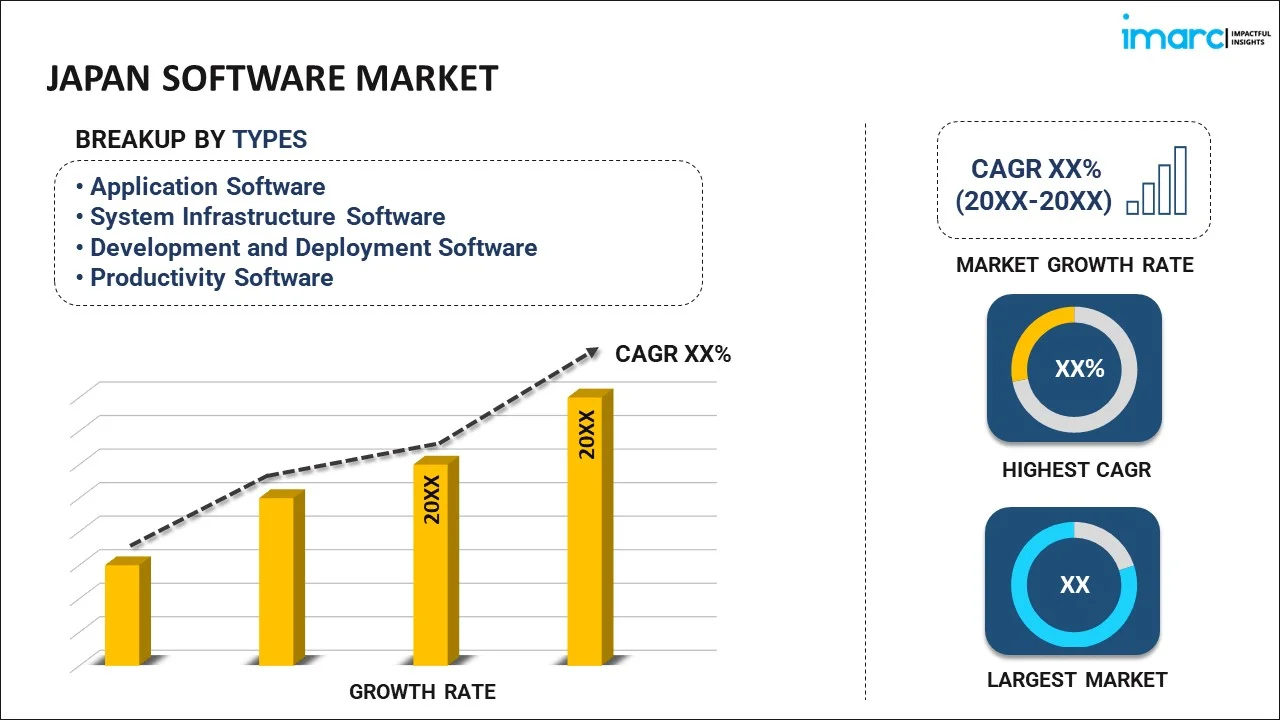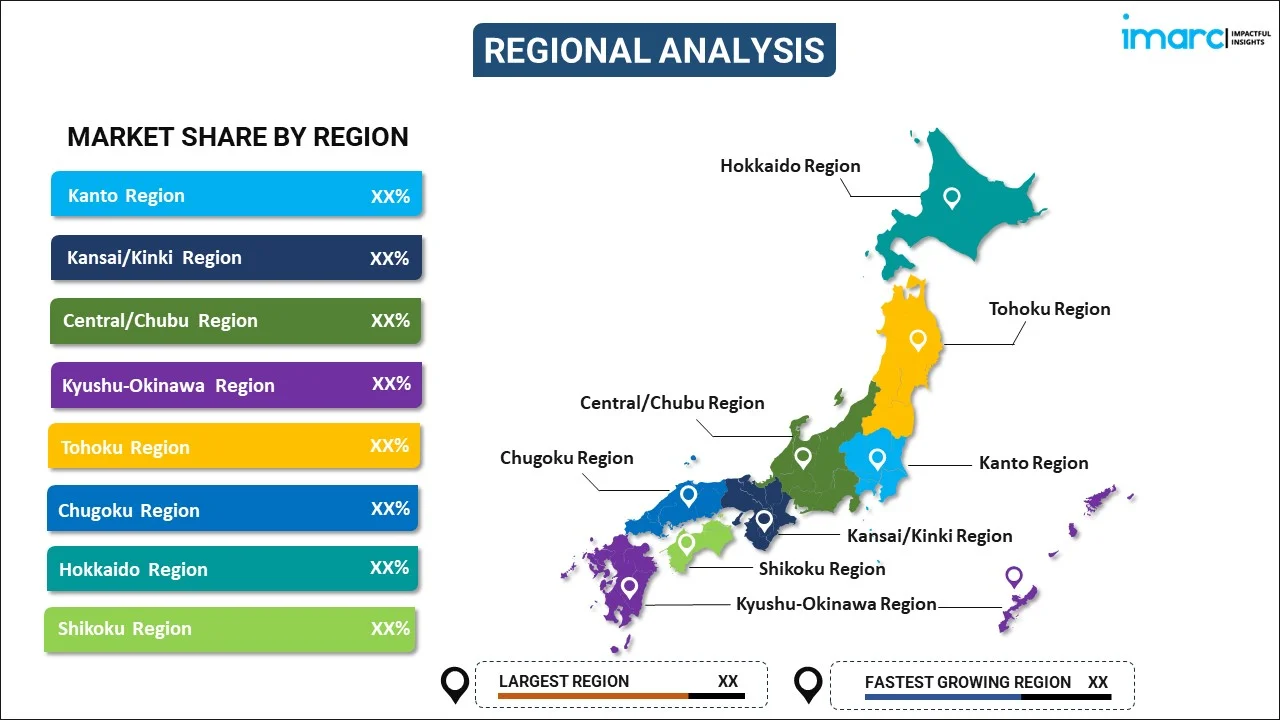
Japan Software Market Report by Type (Application Software, System Infrastructure Software, Development and Deployment Software, Productivity Software), Deployment Mode (On-premises, Cloud-based), Enterprises Size (Small and Medium-Sized Enterprises, Large Enterprises), Industry Vertical (IT and Telecom, BFSI, Retail, Government/Public Sector, Energy and Utilities, Healthcare, and Others), and Region 2025-2033
Market Overview:
Japan software market size reached USD 23.6 Billion in 2024. Looking forward, IMARC Group expects the market to reach USD 33.7 Billion by 2033, exhibiting a growth rate (CAGR) of 4% during 2025-2033. The rapid advancements in technology, such as artificial intelligence, machine learning, blockchain, and cloud computing, which enhance the demand for new and improved software solutions, are driving the market.
|
Report Attribute
|
Key Statistics
|
|---|---|
|
Base Year
|
2024
|
|
Forecast Years
|
2025-2033
|
|
Historical Years
|
2019-2024
|
|
Market Size in 2024
|
USD 23.6 Billion |
|
Market Forecast in 2033
|
USD 33.7 Billion |
| Market Growth Rate 2025-2033 | 4% |
Software refers to a set of instructions, programs, and data that enable computers and other devices to perform specific tasks or functions. It encompasses a wide range of applications, from operating systems that manage hardware resources to user-friendly applications such as word processors and video games. Software can be classified into system software, which controls and coordinates hardware operations, and application software, designed for end-users to accomplish diverse tasks. Programming languages, like Java or C++, are used to create software, and developers follow a structured process known as the software development life cycle (SDLC). Software undergoes constant updates and improvements to enhance functionality, security, and performance. In the rapidly evolving digital landscape, software plays a pivotal role in powering technology and driving innovation across various industries.
Japan Software Market Trends:
Rising Digital Transformation and Industry 4.0
Japan’s push toward digital transformation, aligned with the goals of Industry 4.0, is significantly increasing the overall Japan software market share. In line with this, companies across sectors are adopting advanced software solutions for automation, data analytics, and cloud computing to streamline operations and enhance productivity. This demand is particularly strong in manufacturing, where IoT, AI, and robotics integrations optimize production, which is contributing to the market growth in the country. The government’s policies and incentives for digital innovation further accelerate the adoption of cutting-edge software solutions. Japan’s traditionally hardware-focused industries are increasingly investing in software to maintain a competitive edge, driving the market growth.
Growing Demand for Cybersecurity Solutions
As Japanese businesses continue to digitize, cybersecurity becomes paramount, which is expected to boost the growth of the market in Japan. The rise in cyber threats, including data breaches and ransomware, has created an urgent need for robust cybersecurity software. Organizations are investing in solutions for data protection, network security, and identity management. In addition to this, with the introduction of the Act on the Protection of Personal Information (APPI), companies are required to meet stricter data protection standards, further driving the product demand. Japan’s government also supports cybersecurity advancements, particularly in critical infrastructure sectors, which propels growth in the software market focused on security.
Increasing Cloud Computing and Remote Work Trends
The shift toward cloud computing has witnessed a surge, accelerated by the COVID-19 pandemic and the need for flexible work environments. This is acting as a major growth-inducing factor in the market. Japanese businesses are increasingly adopting cloud-based software solutions to enable remote work, enhance collaboration, and reduce IT costs. Cloud software allows companies to scale operations efficiently, offering flexibility and improving disaster recovery capabilities. Additionally, SaaS (Software as a Service) models are gaining popularity among Japanese businesses for their ease of integration and lower upfront costs. As cloud services become essential for digital resilience, the software market benefits from steady growth in demand for cloud-based applications and infrastructure solutions.
Japan Software Market Segmentation:
IMARC Group provides an analysis of the key trends in each segment of the market, along with forecasts at the country level for 2025-2033. Our report has categorized the market based on type, deployment mode, enterprises size, and industry vertical.
Type Insights:

- Application Software
- Enterprise Resource Planning (ERP)
- Customer Relationship Management (CRM)
- Supply Chain Management (SCM)
- Enterprise Collaboration Software
- Enterprise Content Management (ECM) Software
- Education Software
- Others
- System Infrastructure Software
- Network Management Systems (NMS)
- Storage Software
- Security Software
- Development and Deployment Software
- Enterprise Data Management (EDM)
- Business Analytics and Reporting Tools
- Application Servers
- Integration and Orchestration Middleware
- Data Quality Tools
- Productivity Software
- Office Software
- Creative Software
- Others
The report has provided a detailed breakup and analysis of the market based on the type. This includes application software (enterprise resource planning (ERP), customer relationship management (CRM), supply chain management (SCM), enterprise collaboration software, enterprise content management (ECM) software, education software, and others), system infrastructure software, (network management systems (NMS), storage software, and security software), development and deployment software, (enterprise data management (EDM), business analytics and reporting tools, application servers, integration and orchestration middleware, and data quality tools), and productivity software, (office software, creative software, and others).
Deployment Mode Insights:
- On-premises
- Cloud-based
A detailed breakup and analysis of the market based on the deployment mode have also been provided in the report. This includes on-premises and cloud-based.
Enterprises Size Insights:
- Small and Medium-Sized Enterprises
- Large Enterprises
The report has provided a detailed breakup and analysis of the market based on the enterprises size. This includes small and medium-sized enterprises and large enterprises.
Industry Vertical Insights:
- IT and Telecom
- BFSI
- Retail
- Government/Public Sector
- Energy and Utilities
- Healthcare
- Others
A detailed breakup and analysis of the market based on the industry vertical have also been provided in the report. This includes IT and telecom, BFSI, retail, government/public sector, energy and utilities, healthcare, and others.
Regional Insights:

- Kanto Region
- Kansai/Kinki Region
- Central/ Chubu Region
- Kyushu-Okinawa Region
- Tohoku Region
- Chugoku Region
- Hokkaido Region
- Shikoku Region
The report has also provided a comprehensive analysis of all the major regional markets, which include Kanto Region, Kansai/Kinki Region, Central/ Chubu Region, Kyushu-Okinawa Region, Tohoku Region, Chugoku Region, Hokkaido Region, and Shikoku Region.
Competitive Landscape:
The market research report has also provided a comprehensive analysis of the competitive landscape. Competitive analysis such as market structure, key player positioning, top winning strategies, competitive dashboard, and company evaluation quadrant has been covered in the report. Also, detailed profiles of all major companies have been provided.
Japan Software Market News
- In June 2024, NTT DATA Japan Corporation and DENSO CORPORATION signed a memorandum of understanding (MoU) to form a strategic partnership for software development. The partnership between DENSO, which strengths in vehicle (in-car) technologies including in-vehicle software, and NTT DATA, which has strengths in outside-car technologies including cloud computing, aims to develop and offer in-vehicle software.
- In March 2023, Boomi, the intelligent connectivity and automation leader, announced a new partnership with Works Applications Systems, Co., Ltd. ("WAPS") which provides system development and support, and SI services. WAPS is a group company of Works Applications Co., Ltd., a leading provider of enterprise resource planning (ERP) software solutions for financial and supply chain management. Together, the companies intend to help organizations in their modernization efforts by quickly and easily integrating data from legacy systems, assets, and software as a service (SaaS) applications throughout complex IT environment.
- In January 2024, Keeper Security APAC KK, the leading provider of cloud-based zero-trust and zero-knowledge cybersecurity software protecting privileged access, passwords, passkeys, secrets, and connections, announced that Yayoi Co., Ltd. will become a referral partner for Keeper Security solutions in Japan. This collaboration with the acclaimed accounting software developer, distributor, and support service provider will further Keeper's growth in the Asia-Pacific region and bolster its efforts to protect Japanese businesses, owners, and entrepreneurs from damaging cyberattacks and data breaches.
Japan Software Market Report Coverage:
| Report Features | Details |
|---|---|
| Base Year of the Analysis | 2024 |
| Historical Period | 2019-2024 |
| Forecast Period | 2025-2033 |
| Units | Billion USD |
| Scope of the Report | Exploration of Historical and Forecast Trends, Industry Catalysts and Challenges, Segment-Wise Historical and Predictive Market Assessment:
|
| Types Covered |
|
| Deployment Modes Covered | On-premises, Cloud-based |
| Enterprises Sizes Covered | Small and Medium-Sized Enterprises, Large Enterprises |
| Industry Verticals Covered | IT and Telecom, BFSI, Retail, Government/Public Sector, Energy and Utilities, Healthcare, Others |
| Regions Covered | Kanto Region, Kansai/Kinki Region, Central/ Chubu Region, Kyushu-Okinawa Region, Tohoku Region, Chugoku Region, Hokkaido Region, Shikoku Region |
| Customization Scope | 10% Free Customization |
| Post-Sale Analyst Support | 10-12 Weeks |
| Delivery Format | PDF and Excel through Email (We can also provide the editable version of the report in PPT/Word format on special request) |
Key Questions Answered in This Report:
- How has the Japan software market performed so far and how will it perform in the coming years?
- What has been the impact of COVID-19 on the Japan software market?
- What is the breakup of the Japan software market on the basis of type?
- What is the breakup of the Japan software market on the basis of deployment mode?
- What is the breakup of the Japan software market on the basis of enterprises size?
- What is the breakup of the Japan software market on the basis of industry vertical?
- What are the various stages in the value chain of the Japan software market?
- What are the key driving factors and challenges in the Japan software?
- What is the structure of the Japan software market and who are the key players?
- What is the degree of competition in the Japan software market?
Key Benefits for Stakeholders:
- IMARC’s industry report offers a comprehensive quantitative analysis of various market segments, historical and current market trends, market forecasts, and dynamics of the Japan software market from 2019-2033.
- The research report provides the latest information on the market drivers, challenges, and opportunities in the Japan software market.
- Porter's five forces analysis assist stakeholders in assessing the impact of new entrants, competitive rivalry, supplier power, buyer power, and the threat of substitution. It helps stakeholders to analyze the level of competition within the Japan software industry and its attractiveness.
- Competitive landscape allows stakeholders to understand their competitive environment and provides an insight into the current positions of key players in the market.
Need more help?
- Speak to our experienced analysts for insights on the current market scenarios.
- Include additional segments and countries to customize the report as per your requirement.
- Gain an unparalleled competitive advantage in your domain by understanding how to utilize the report and positively impacting your operations and revenue.
- For further assistance, please connect with our analysts.
 Inquire Before Buying
Inquire Before Buying
 Speak to an Analyst
Speak to an Analyst
 Request Brochure
Request Brochure
 Request Customization
Request Customization




.webp)




.webp)












